What Are the Best Practices for Introducing Cats to New Home Environments?
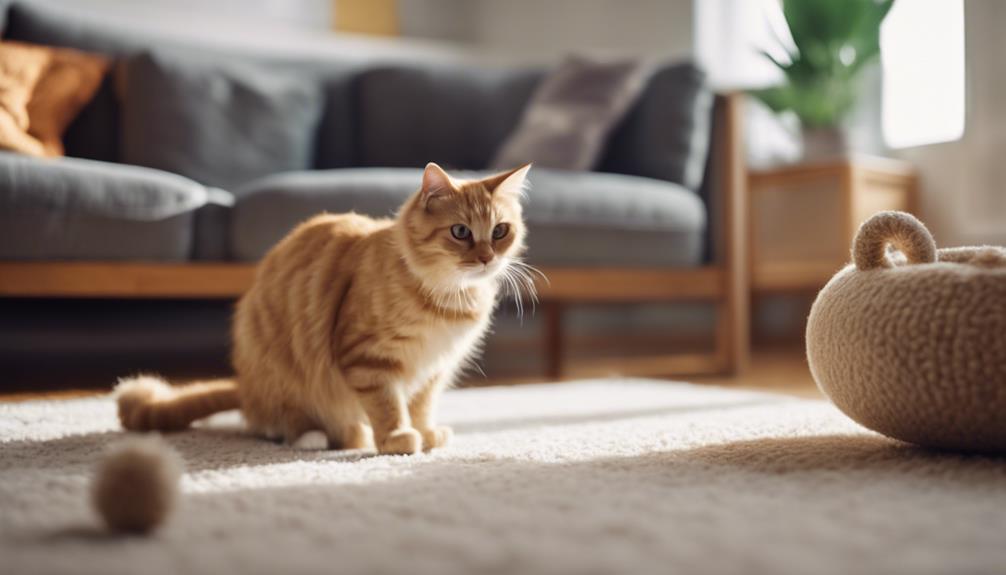
Introducing a new cat to a home environment can be a delicate process that requires patience and careful planning. Here are some best practices to help ensure a smooth transition:
- Create a safe space for the new cat to acclimate to its surroundings. This could be a separate room with all the essentials, like food, water, litter box, and toys.
- Allow the new cat to explore its new surroundings at its own pace. Avoid overwhelming it with too much interaction or noise initially.
- Gradually introduce the new cat to other pets in the household. This can be done through scent swapping and supervised interactions.
- Provide plenty of vertical space for the new cat to perch and observe its surroundings. This will help the cat feel more secure in its new environment.
- Establish a routine for feeding, playtime, and litter box cleaning to help the new cat feel more comfortable and secure.
- Monitor the new cat's behavior and interactions with other pets closely during the initial introduction period. Be prepared to intervene if any conflicts arise.
By following these best practices, you can help your new cat adjust to its new home environment and ensure a successful transition for both the cat and your existing pets.
Establishing Safe Zones
To ensure a smooth transition for cats into new home environments, establish safe zones where they can familiarize themselves with their surroundings and feel secure. Comfort zones play a crucial role in helping cats acclimate to unfamiliar surroundings. These designated areas provide cats with personal space, allowing them to retreat to a familiar and calming atmosphere when feeling overwhelmed. It's essential to set up these safe zones in quiet, low-traffic areas of the home.
Incorporating familiar scents, such as bedding or toys from their previous environment, can further help in creating a sense of security for the cats. Additionally, providing hiding spots like cat condos or covered beds within these safe zones can offer cats a sense of protection and privacy. By respecting the cat's need for personal space and ensuring the safe zone remains a peaceful sanctuary, owners can facilitate a smoother transition for their feline companions into their new home.
Slowly Introduce Scent Exchange
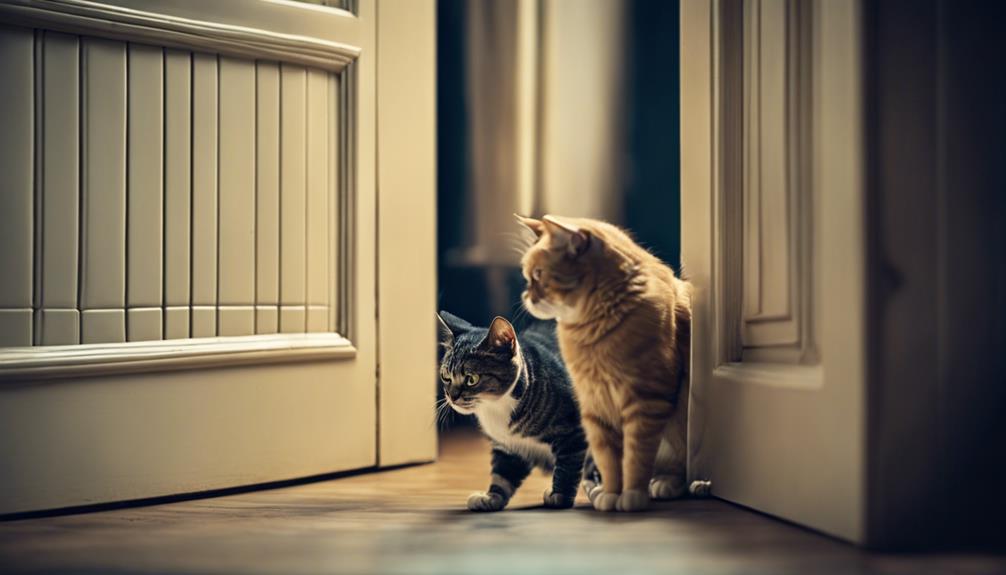
Gradually introducing scent exchange between new and existing items can help familiarize cats with the environment and reduce their stress levels. This gradual introduction allows cats to create positive scent associations, making them feel more secure in their new surroundings.
Here are three key steps to effectively implement scent exchange:
- Exchange bedding: Swap bedding or blankets between the cats to introduce each other's scents in a non-threatening way.
- Rubbing objects: Encourage cats to rub their scent on common objects like toys or scratching posts, helping them establish familiarity with shared items.
- Use a soft cloth: Gently rub a soft cloth on one cat's scent glands and then rub it on the other cat to blend their scents, aiding in the gradual introduction process.
Providing Cozy Hideaways
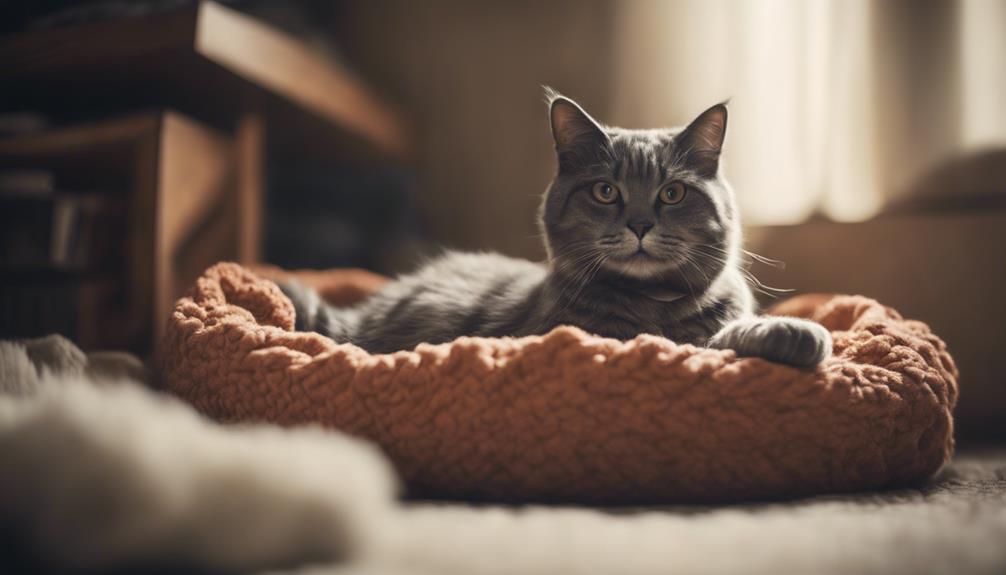
Introducing cats to cozy hideaways in their new home environment can provide them with secure retreats where they can feel safe and comfortable as they adjust to their surroundings. Cats often seek out quiet and private spaces where they can relax without feeling exposed. By offering designated cozy hideaways, you can help your cat settle into their new environment more smoothly. Here are some key elements to consider when setting up these retreats:
| Comfortable Bedding | Calming Scents | Privacy Spots |
|---|---|---|
| Providing soft, plush beds or blankets can offer a cozy place for your cat to rest. | Using pheromone diffusers or sprays with calming scents like lavender can help reduce stress. | Creating hiding spots using cat trees, covered beds, or cardboard boxes can give your cat a sense of security. |
| Ensuring the bedding is clean and placed in a quiet area can enhance your cat's comfort. | Introducing scents gradually can aid in familiarizing your cat with their new surroundings. | Positioning these spots in low-traffic areas can give your cat the privacy they desire. |
| Regularly washing bedding to maintain cleanliness is essential for your cat's well-being. | Scent association can help your cat feel more at ease as they explore their hideaways. | Rotating different hiding spots can prevent your cat from becoming bored with their retreats. |
Implementing a Feeding Routine
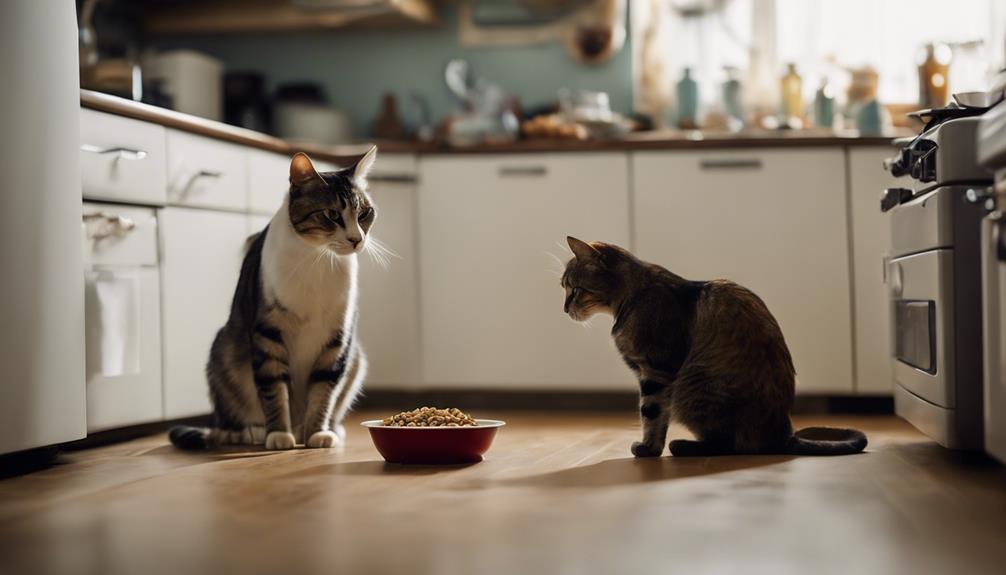
When introducing a cat to a new home environment, establishing a feeding routine is crucial. Mealtime consistency is important for cats as it provides them with a sense of security and predictability.
Scheduled feeding not only helps regulate their digestion but also allows for monitoring their food intake.
Mealtime Consistency Importance
To ensure a smooth transition for your cat in a new home environment, establishing a consistent feeding routine is essential. This routine structure helps create a sense of security for your feline friend, promoting their well-being and comfort.
Here are some key points to consider when implementing a feeding schedule for your cat:
- Regular Feeding Times: Set specific times for feeding each day to establish a predictable routine.
- Designated Feeding Area: Create a quiet and calm space for meals to reduce stress and distractions.
- Balanced Diet: Ensure your cat receives a nutritionally balanced diet tailored to their age, weight, and health needs.
Scheduled Feeding Benefits
Establishing a scheduled feeding routine for your cat brings numerous benefits that contribute to their overall well-being and comfort. Consistent feeding schedules play a crucial role in weight management, ensuring your cat maintains a healthy weight. Moreover, by following a regular feeding routine, you can help your cat achieve optimal nutritional balance, leading to various health benefits. Here is a table highlighting the advantages of implementing a scheduled feeding routine for your feline companion:
| Benefits | Description |
|---|---|
| Weight Management | Helps maintain a healthy weight for your cat |
| Nutritional Balance | Ensures your cat receives the right nutrients |
| Health Benefits | Promotes overall well-being and reduces health risks |
Encouraging Play and Exploration
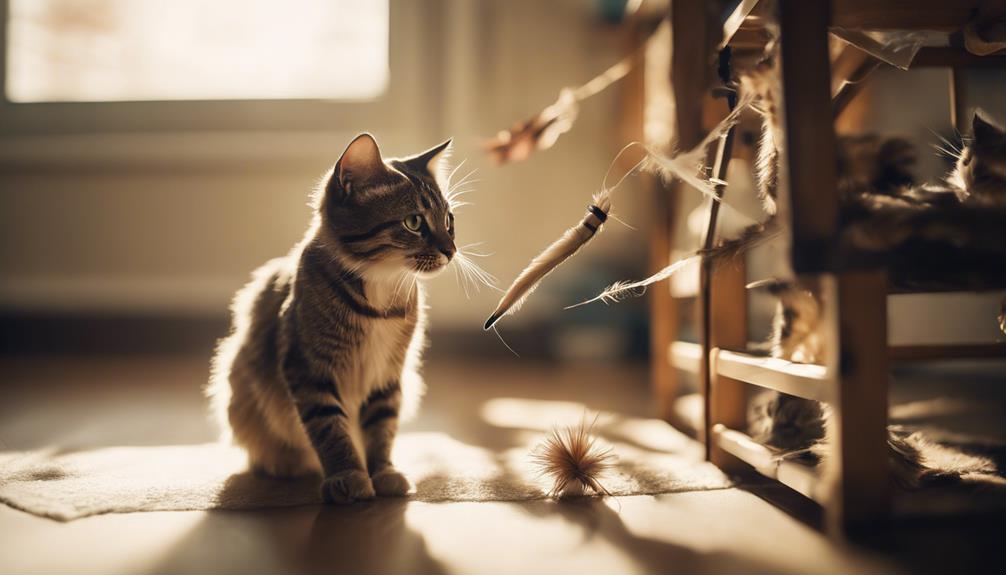
To encourage play and exploration in cats, providing interactive toys for engagement is essential. Cats thrive on activities that stimulate their senses and challenge their minds.
Setting up a safe environment with hidden spots for exploration can also help in keeping the cat engaged and curious.
Interactive Toys for Engagement
Encouraging play and exploration in cats can be effectively achieved through the use of interactive toys that stimulate their natural instincts and curiosity. Interactive play and stimulation are essential for keeping cats mentally and physically engaged.
To promote healthy behaviors and prevent boredom, consider incorporating the following interactive toys into your cat's environment:
- Puzzle feeders: These toys dispense treats or kibble as the cat plays, encouraging problem-solving skills and physical activity.
- Enrichment balls: Cats can bat around these balls to release hidden treats or kibble, providing mental stimulation and rewarding play.
- Feather wands: Mimicking prey-like movements, feather wands trigger your cat's hunting instincts, promoting exercise and engagement.
Safe Environment Setup
To create a safe and engaging play environment for cats, ensure all potential hazards are removed or secured. Arrange cat friendly furniture like scratching posts, cat trees, and cozy beds to encourage exploration and play.
Consider the room layout when setting up spaces for your cat to roam freely and feel secure. Cat proofing is essential to prevent accidents; secure windows, hide electrical cords, and store household chemicals out of reach.
Provide enrichment activities such as puzzle feeders, interactive toys, and window perches to keep your cat mentally stimulated. A safe environment setup not only encourages play and exploration but also fosters a sense of security and well-being in your feline companion.
Monitoring Behavioral Cues
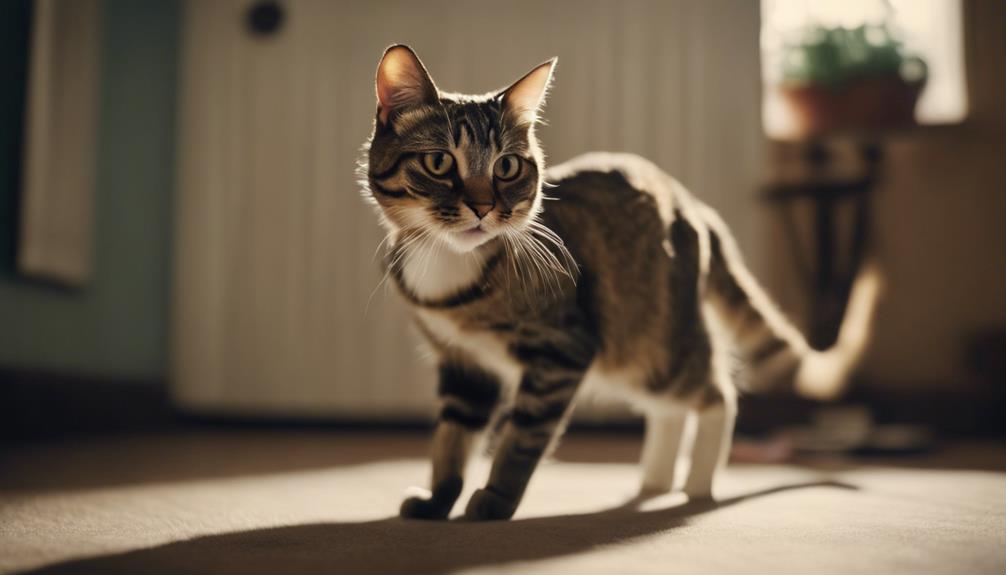
When observing a cat in a new home environment, pay close attention to its behavioral cues to understand how it's adapting to the surroundings and level of comfort. Cats communicate through their behavior, and monitoring these cues can provide valuable insights into their well-being and adjustment process. Here are some key points to consider:
- Body Language Interpretation: Watch for signs like flattened ears, dilated pupils, or a tucked tail, which may indicate stress or discomfort.
- Gradual Acclimation: Allow the cat time to explore the new environment at its own pace, gradually introducing it to different areas of the home.
- Environmental Enrichment: Provide stimulating toys, scratching posts, hiding spots, and vertical spaces to promote mental and physical exercise, aiding in the cat's adjustment.
Seeking Professional Guidance

Seeking professional guidance can be instrumental in ensuring the well-being and successful integration of your cat into its new home environment. Behavior consultation with a certified feline behaviorist or veterinarian specializing in behavior can provide valuable insights into understanding your cat's actions and reactions during the transition period. These experts can offer expert advice on how to create a conducive environment for your cat, address any behavioral issues that may arise, and recommend strategies to help your cat acclimate smoothly to its new surroundings.
Professional guidance can also help in identifying signs of stress or anxiety in your cat and provide tailored solutions to alleviate these feelings. By seeking expert advice early on, you can proactively address any challenges that may impede your cat's adjustment to its new home. Additionally, behavior consultation can offer personalized recommendations based on your cat's specific needs and temperament, ensuring a more tailored approach to helping your feline companion feel comfortable and secure in its new environment.
Frequently Asked Questions
How Can I Prevent My Cats From Fighting When Introducing Them to a New Home Environment?
When bringing new feline friends together in a fresh abode, behavioral training and socialization techniques are key. By gradually introducing them, using positive reinforcement, and creating safe spaces, preventing cat conflicts becomes a purr-fect possibility.
What Should I Do if One of My Cats Is Showing Signs of Stress or Anxiety During the Introduction Process?
If a cat shows stress during introductions, try stress management techniques like creating a safe space, using calming pheromones, and providing interactive toys. Behavioral training and desensitization exercises can help ease anxiety and build confidence.
Are There Any Specific Toys or Products That Can Help Make the Transition Easier for My Cats?
Interactive play and enrichment toys can provide comfort and security during the transition to a new home for cats. Offering toys that stimulate their senses and provide mental stimulation can help ease the adjustment process.
How Long Should I Wait Before Allowing My Cats to Interact Freely in the New Environment?
When introducing cats to a new home, it's important to allow gradual integration. Supervised interactions can help establish positive relationships. Provide safe spaces for each cat and use positive reinforcement to encourage harmonious cohabitation.
What Are Some Common Mistakes to Avoid When Introducing Cats to a New Home Environment?
When introducing cats to a new home, some common mistakes to avoid include skipping proper introduction techniques and not establishing safe spaces. These oversights can lead to stress, aggression, and territorial issues between feline residents.











